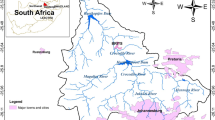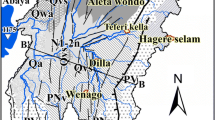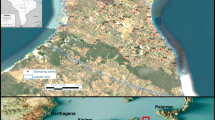Abstract
A wide range of lithologic units and tectonic disturbances by cross-cutting faults and folds has resulted in the quite complex hydrogeological setting of the sedimentary outlier and its surroundings at Mekelle, northern Ethiopia. The environmental isotopes of oxygen and hydrogen and patterns of dissolved ion concentrations in the groundwater, coupled with understanding of the three-dimensional geological framework, are used to conceptualize the groundwater flow model and recharge–discharge mechanisms in the area. In agreement with the piezometric-surface map, recharge areas are determined to be the highlands (northwest, north, east and south of the study area), characterized by relatively more depleted isotopic compositions, higher d-excess, and lower concentrations of dissolved ions in the groundwater samples; the narrow major river valleys of Giba, Illala, Chelekot and Faucea Mariam are discharge areas. The groundwater divide between the Tekeze and the Denakil basins coincides with the surface-water divide line of these two basins. In most cases, groundwater feeds the semi-perennial streams and rivers in the area. However, isotopic signatures in some wells indicate that there are localities where river flow and seepage from micro-dams locally feed the adjacent aquifers. The lithostratigraphic, geomorphologic, isotopic and hydrochemical settings observed in this study indicate that three groundwater flow systems (shallow/local, intermediate and deep/semi-regional) can exist here. Tritium data indicate that the groundwater in the study area has generally short residence time and is dependent on modern precipitation.
Résumé
Une large gamme d’unités lithologiques et de perturbations tectoniques par des failles et plis entrecroisés créent un schéma hydrogéologique relativement complexe de formations sédimentaires aux environs de Mekelle, nord de l’Éthiopie. Les isotopes environnementaux de l’oxygène et de l’hydrogène et le schéma des concentrations en ions dissous dans les eaux souterraines, couplés avec la compréhension du schéma géologique tridimensionnel, ont été utilisés pour conceptualiser le modèle des écoulements souterrains et les mécanismes de recharge et décharge dans cette région. En accord avec la carte piézométrique, les zones de recharge ont été délimitées dans les montagnes (nord-est, nord, est et sud de la zone d’étude), caractérisées par une composition isotopique relativement appauvrie, un excès en deutérium élevé et de faibles concentrations en ions dissous dans les eaux souterraines; les étroites vallées des rivières principales Giba, Illala, Chelekot et Faucea Mariam sont les lieux de décharge. La zone de partage des écoulements souterrains entre les bassins de Tekeze et Denakil coïncide avec la zone de partage des eaux de surface de ces deux bassins versants. Dans la plupart des cas, les eaux souterraines alimentent les fleuves et rivières semi-pérennes de cette région. Toutefois, les signatures isotopiques de quelques puits indiquent qu’il y a des localités où les flux de rivières et les infiltrations de micro-barrages alimentent localement les aquifères limitrophes. Le cadre litho-stratigraphique, géomorphologique, isotopique et hydrochimique décrit dans cette étude indique que trois systèmes de flux d’eau souterraine (peu profond/local, intermédiaire, profond/semi-régional) peuvent coexister ici. Les données de tritium indiquent que les eaux souterraines de cette région d’étude ont généralement un court temps de résidence et dépendent des précipitations actuelles.
Resumen
Un amplio rango de unidades litológicas y de perturbaciones tectónicas por fallas transversales y pliegues ha resultado en una configuración hidrogeológica muy compleja del afloramiento sedimentario y sus alrededores en Mekelle, en el norte de Etiopía. Se usaron los isótopos ambientales de oxígeno e hidrógeno y sus patrones de concentraciones de iones disueltos en el agua subterránea, conjuntamente con la comprensión del marco geológico tridimensional, para conceptualizar el modelo de flujo de agua subterránea y los mecanismos de recarga – descarga en el área. De acuerdo con el mapa de la superficie piezométrica, las áreas de recarga se determinaron para las tierras altas (norte, este, y sur del área de estudio), caracterizadas por una composición de isótopos relativamente más empobrecidas, mayores excesos de deuterio, y bajas concentraciones de iones disueltos en las muestras de agua subterránea; los estrechos valles de los ríos principales de Giba, Illala, Chelekot y Faucea Mariam son áreas de descarga. La divisoria de agua subterránea entre las cuencas de Tekeze y Denakil coincide con las líneas de divisorias de agua superficial de estas dos cuencas. En la mayoría de los casos, el agua subterránea alimenta a corrientes y ríos semipermanentes en el área. Sin embargo, las firmas isotópicas en algunos pozos indican que hay localidades donde el flujo del río y la filtración desde micro presas alimentan localmente a los acuíferos adyacentes. Las configuraciones litoestratigráfica, geomorfológica, isotópica e hidroquímica observadas en este estudio indican que allí pueden existir tres sistemas de flujo de agua subterránea (somero / local, intermedio y profundo / semi-regional) pueden existir aquí. Los datos de tritio indican que el agua subterránea en el área de estudio tiene generalmente un tiempo de residencia corto y depende de las precipitaciones actuales.
摘要
大范围的岩性单元及横切断层和皱褶造成的构造扰动使埃塞俄比亚北部沉积外露层及周边地区的水文地质背景相当复杂。地下水中的氧和氢环境同位素及溶解离子含量,加上对三维地质结构的认识,用来概念化地下水流模型和本地的补给-排泄机理。与压力水面图相符,补给区处于(研究区西北部、北部、东部和南部的)高地,特点就是地下水样品中同位素组分相对枯竭,氚含量较高以及溶解离子较低;Giba, Illala, Chelekot 和 Faucea Mariam狭窄的主要河谷是排泄区。Tekeze流域和Denakil之间的地下水分水岭与这两个流域的地表分水线相一致。在大部分情况下,地下水补给本地区的半常流河。然而,一些井中的同位素特征显示有些地方河水水流和小型水坝的渗流局部上补给毗邻的含水层。本研究中观测到的岩性地层、地貌、同位素和水化学背景表明,这里可能存在着三个地下水流系统(浅层/局部系统、中间系统和深层/半区域系统)。氚资料显示研究区的地下水通常停留时间较短,这取决于现代降水量。
Resumo
Uma grande gama de unidades litológicas e de distúrbios tectónicos causados por falhas e dobras que afetam as estruturas geológicas resultaram num ambiente hidrogeológico muito complexo dos afloramentos sedimentares e das unidades envolventes em Mekelle, no norte da Etiópia. Os isótopos ambientais de oxigénio e hidrogénio e os padrões das concentrações dos iões dissolvidos na água subterrânea, acoplados ao conhecimento da estrutura geológica tridimensional, são usados para concetualizar o modelo de fluxo e os mecanismos de recarga-descarga na área. De acordo com o mapa da superfície piezométrica, as áreas de recarga são determinadas pelas terras altas (noroeste, norte, este e sul da área de estudo), caraterizadas por uma composição isotópica relativamente mais deficitária, maior excesso de d e menores concentrações de iões dissolvidos nas amostras de água subterrânea; os vales estreitos dos rios principais, o Giba, o Illala, o Chelekot e o Faucea Mariam, correspondem a áreas de descarga. A divisória de águas subterrâneas entre as bacias de Tekeze e de Denakil coincide com a divisória das águas superficiais destas duas bacias. Na maior parte dos casos, a água subterrânea alimenta os fluxos semi-perenes e os rios da área. No entanto, as assinaturas isotópicas nalguns poços indicam que há locais onde o fluxo dos rios e a drenância a partir de micro-barragens alimentam localmente os aquíferos adjacentes. As estruturas litoestratigráficas, geomorfológicas, isotópicas e hidroquímicas observadas neste estudo indicam que podem existir aqui três sistemas de fluxo de água subterrânea (pouca profundidade/local, intermédio e profundo/semi-regional). Os dados de trítio indicam que a água subterrânea na área de estudo tem geralmente um tempo de residência curto e que é dependente de precipitação moderna.


















Similar content being viewed by others
References
Aggarwal PK, Froelich K, Gonfiantini R, Gat JR (2005) Isotope hydrology: a historical perspective from the IAEA. In: Aggarwal PK, Gar JR, Froelich KFO (eds) Isotopes in the water cycle: past, present and future of a developing science. Springer, Berlin, 381 pp
Alemayehu T (2006) Groundwater occurrence in Ethiopia. Addis Ababa University Press, Addis Ababa, Ethiopia, 106 pp
Alene M (1998) Tectonomagmantic evolution of the Neoproterozoic rocks of the Mai Kenetal-Negasharea, northern Ethiopia. PhD Thesis, University of Turin, Turin, Italy, 260 pp
Alene M, Jenkin GRT, Leng MJ, Darbyshire DPF (2006) The Tambien Group, Ethiopia: an early Cryogenian (ca. 800–735 Ma) Neoproterozoic sequence in the Arabian-Nubian shield. Precambrian Res 147:79–99
Arkin V, Beyth M, Dow DB, Levitte D, Haile T (1971) Geological map of Mekele sheet (ND 37–11). Ethiopian Institute of Geological Survey (EIGS), Addis Ababa, Ethiopia
Ayenew T (1998) The hydrogeological system of the Lake District basin. Central Main Ethiopian Rift. PhD Thesis, Free University of Amsterdam, The Netherlands, 259 pp
Ayenew T (2003) Environmental isotope-based integrated hydrogeological study of some Ethiopian rift lakes. J Radioanal Nucl Chem 257(1):11–16
Ayenew T, Alemayehu T (2001) Principles of hydrogeology. Addis Ababa University Press, Addis Ababa, Ethiopia,125 pp
Begemann F, Libby WF (1957) Continental water balance, ground water inventory and storage times, surface ocean mixing rates and world-wide circulation patterns from cosmic-ray and bomb tritium. Geochim Cosmochim Acta 12:277–296
Beyth M (1972) The geology of central and western Tigre. PhD Thesis, University of Bonn, Germany, 155 pp
Beyth M, Shachnai E (1970) Hydrogeology of Mekelle area. Ethiopian Institute of Geological Survey (EIGS), Addis Ababa, Ethiopia, 10 pp
Bossellini A, Russo A, Fantozzy PL, Assefa G, Tadesse S (1997) The Mesozoic succession of Mekelle Outlier (Tigre Province, Ethiopia). Mem Sci Geol 49:95–116
Chernet T, Eshete G (1982) Hydrogeology of Mekelle area (ND37-11). Memoir No. 2, Ministry of Mines and Energy and Ethiopian Institute of Geological Survey, Addis Ababa, Ethiopia, 49 pp
Clark ID, Fritz P (1997) Environmental isotopes in hydrogeology. Lewis, Boca Raton, FL, 328 pp
Consult DH (2010) Groundwater resources potential assessment of the Mekelle outlier: phase II report. Ministry of Water Resources, Addis Ababa, Ethiopia, 153 pp
Craig H (1961) Isotopic variations in meteoric waters. Science 133:1702–1703. doi:10.1126/science.133.3465.1702
Darling GW, Gizaw B, Arusel MK (1996) Lake-groundwater relationships and fluid-rock interaction in the East African Rift Valley: isotope evidence. J Afr Earth Sci 22:423–431
Demilie M, Wohnlich S, Gizaw B, Stichler W (2006) Groundwater recharge in the Akaki catchment, central Ethiopia: evidence from environmental isotopes (δ18O, δ2H and 3H) and chloride mass balance. Hydrol Process 21:807–818
Demilie M, Wohnlich S, Wisotzky F, Gizaw B (2007) Groundwater recharge, flow and hydrochemical evolution in complex volcanic aquifer system, central Ethiopia. Hydrogeol J 15:1169–1181
EIGS/Ethiopian Institute of Geological Survey (1993) Hydrogeological map of Ethiopia, 1:2,000,000 scale. Ministry of Mines and Energy and Ethiopian Institute of Geological Survey (EIGS), Addis Ababa, Ethiopia
EIGS/Ethiopian Institute of Geological Survey (1996) Explanation of the geological map of Ethiopia (scale 1:2,000,000), 2nd edn. Ethiopian Institute of Geological Survey, Addis Ababa, Ethiopia, 79 pp
Fetter CW (1994) Applied hydrogeology. Prentice Hall, Englewood Cliffs, NJ, 604 pp
Furi W, Razack M, Ayenew T, Kebede S, Legese D (2011) Hydrochemical characterization of complex volcanic aquifers in a continental rift zone: the Middle Awash Basin Ethiopia. Hydrogeol J 20:325–400
FWWDSE/Federal Water Works Design and Supervision Enterprise (2007) Evaluation of Aynalem well fields around Mekelle town for water supply source: final report, vol II. Addis Ababa, Ethiopia, 147 pp
Garland CR (1980) Geology of the Adigrat area. Memoir, no. 1. Ministry of Mines, Addis Ababa, Ethiopia, 51 pp
Gebreyohannes T (2009) Regional groundwater flow model of Giba Basin, northern Ethiopia. PhD Thesis, Vrije Universiteit Brussel, Belgium, 256 pp
Gebreyohannes T, Smedt FD, Hagos M, Amare K, Kabeto K, Hussein A, Nyssen J, Bauer H, Moeyersons J, Deckers J, Taha N (2009) Large-scale geological mapping of the Geba basin, northern Ethiopia. VLIR-Mekelle University IUC program, Tigray Livelihood Papers 9, Mekelle University, Mekelle, Ethiopia, 46 pp
Getaneh W (2002) Geochemistry province and depositional tectonic setting of the Adigrat Sandstone northern Ethiopia. J Afr Earth Sci 35:185–198
Gibson JJ, Edwards TWD, Birks SJ, St Amour NA, Buhay WM, McEachern P, Wolfe BB, Peters DL (2005) Progress in isotope tracer hydrology in Canada. Hydrol Process 19:303–327
Hoefs J (2009) Stable isotope geochemistry, 6th edn. Springer, Berlin, 285 pp
Hunkeler D, Aravena R, Butler B (1999) Monitoring microbial dechlorination of tetrachloroethene (PCE) in groundwater using compound-specific stable carbon isotope ratios: microcosm and field studies. Environ Sci Technol 33:2733–2738
Hussein A (2000) Hydrogeology of the Aynalem well field. MSc Thesis, Addis Ababa University, Ethiopia, 103 pp
Kazmin V (1979) Stratigraphy and correlation of volcanic rocks of Ethiopia. EIGS Note no. 106, Ethiopian Institute of Geological Surveys, Addis Ababa, Ethiopia, pp 1–26
Kebede S (2004) Approches isotopique et geochimique pour l’etudedes eauxsouterraines et des lacs: exemples du haut bassin du Nil Bleu et du rift Ethiopien [Environmental isotopes and geochemistry in groundwater and lake hydrology: cases from the Blue Nile basin, main Ethiopian rift and Afar, Ethiopia]. PhD Thesis, University of Avignon, France, 162 pp
Kebede S (2013) Groundwater in Ethiopia features, numbers and opportunities. Springer, Berlin, 121 pp
Kebede S, Travi Y (2012) Origin of the δ18O and δ2H composition of meteoric waters in Ethiopia. Quat Int 257:4–12
Kebede S, Travi Y, Alemayehu T, Ayenew T (2005) Groundwater recharge, circulation and geochemical evolution in the source region of the Blue Nile River, Ethiopia. Appl Geochem 20:1658–1676
Kebede S, Travi Y, Asrat A, Alemayehu T, Ayenew T, Tessema Z (2008) Groundwater origin and flow along selected transects in Ethiopian rift volcanic aquifers. Hydrogeol J 16:55–73
Kendall C, Coplen TB (2001) Distribution of oxygen-18 and deuterium in river waters across the United States. Hydrol Process 15:1363–1393
Kuster D, Dwivedi SB, Kabeto K, Mehari K, Matheis G (2005) Petrograhic reconnaissance investigation of mafic sills associated with flood basalts, Mekelle basin, northern Ethiopia: implications for Ni–Cu Exploration. J Geochem Explor 85:63–79
Merla G, Abate E, Azzaroli A, Bruni P, Fazzuoli M, Sagri M (1979) Comments to the geological map of Ethiopia and Somalia. Consiglio Nazionale delle Ricerche, Rome, 95 pp
Moser H, Stichler W (1971) Die Verwendung des Deuterium und Sauerstoff-18 Gehalts bei Hydrologischen Untersuchungen. Geol. Bavarica 64:7–35
Newman BD, Osenbrück K, Aeschbach-Hertig W, Solomon DK, Cook P, Różański K, Kipfer R (2010) Dating of ‘young’ groundwaters using environmental tracers: advantages, applications, and research needs. Isot Environ Health Stud 46(3):259–278. doi:10.1080/10256016.2010.514339
Rietti-Shati M, Yam R, Karlen W, Shemesh A (2000) Stable isotope composition of tropical high-altitude fresh-waters on Mt. Kenya, Equatorial East Africa. Chem Geol 166:341–350
Rozanski K, Araguas-Araguas L (1995) The spatial and temporal variability of stable isotope composition of precipitation over the South American continent. In: Kebede S, Travi Y (2012) Origin of the δ18O and δ2H composition of meteoric waters in Ethiopia. Quat Int 257:4–12
Sanford WA, Aeschbach-Hertig W, Andrew L, Herczeg AL (2011) Insights from environmental tracers in groundwater systems. Hydrogeol J 19:1–3
Schmidt TC, Zwank L, Elsner M, Berg M, Meckenstock RU, Haderlein SB (2004) Compound-specific stable isotope analysis of organic contaminants in natural environments: a critical review of the state of the art, prospects and future challenges. Anal Bioanal Chem 378:283–300
Singhal B, Gupta R (2010) Applied hydrogeology of fractured rocks, 2nd edn. Springer, Heidelberg, Germany, 408 pp
Verhagen BT (1991) Detailed geohydrology with environmental isotopes: a case study at Seroew, Botswana. In: Isotope techniques in water resources development. IAEA, Vienna, pp 345–362
Weldesenbet S (2012) Hydrogeology, hydrochemistry and isotope hydrology of Central Main Ethiopian Rift. PhD Thesis, Ruhr Universitat Bochum, Germany, 175 pp
Yihdego S (2003) Hydrogeological assessment of the Ellala-Aynalem catchments with particular reference to the chemical variation and aquifer characterization, northern Ethiopia. MSc, Thesis, Addis Ababa University, Ethiopia, 183 pp
Yitbarek A, Razack M, Ayenew T, Zemedagegnehu E, Azagegn T (2012) Hydrogeological and hydrogeochemical framework of Upper Awash River basin, Ethiopia: with special emphasis on inter-basins groundwater transfer between Blue Nile and Awash River. J Afr Earth Sci 65:46–60
Zereay T (2007) Evaluating the potential of the Aynalem wellfield for the conjunctive use of surface and groundwater. MSc Thesis, Mekelle University, Ethiopia, 113 pp
Acknowledgements
The results presented here are part of ongoing PhD research work at Adiss Ababa University (Ethiopia) and Ruhr Universitat Bochum (Germany) and are supported by the German Academic Exchange service (DAAD). Therefore, the authors would like to acknowledge the financial, logistical and laboratory support of these institutions. We also thank the three anonymous reviewers and the editors of the Hydrogeology Journal for their constructive comments and suggestions.
Author information
Authors and Affiliations
Corresponding author
Electronic supplementary material
Below is the link to the electronic supplementary material.
ESM 1
(PDF 53 kb)
Rights and permissions
About this article
Cite this article
Girmay, E., Ayenew, T., Kebede, S. et al. Conceptual groundwater flow model of the Mekelle Paleozoic–Mesozoic sedimentary outlier and surroundings (northern Ethiopia) using environmental isotopes and dissolved ions. Hydrogeol J 23, 649–672 (2015). https://doi.org/10.1007/s10040-015-1243-4
Received:
Accepted:
Published:
Issue Date:
DOI: https://doi.org/10.1007/s10040-015-1243-4




